Homebush Council Chambers
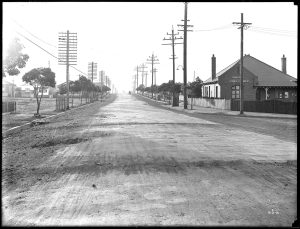
Parramatta Road with the Homebush Council Chambers (right) on the corner of Wentworth Road (now Park Road), 1921.
Courtesy NSW State Archives and Records.
When was the last time you saw no traffic on Parramatta Road? This photo shows a very quiet stretch during reconstruction in 1921. Homebush Council contributed half the cost (£3085) to the project but was ‘very disappointed with the manner in which the work of reconstructing Parramatta Road had been carried out, and considered that for the large amount of money expended it was a very unsatisfactory job.’[1]
On the left are several Federation-style homes fronting Crane Street. Homebush Council Chambers stand on the right, on the corner of Park Road (formerly Wentworth Road). Built in 1912, as a home for the council incorporated in 1906, this simple building was the venue for meetings and celebrations over many years. The foundation stone was laid with a silver trowel by the mayor, Alderman George Dalton, on 9 November 1912.
‘The building, which is to be constructed of brick, with a tiled roof, is to contain a Mayor’s room, a town clerk’s office, and a public hall – 35ft. by 18ft. – and is to cost (including the land) £1000.’[2]
At a special meeting held on 17 December however, Homebush Council accepted the architect’s recommendation to substitute slates for tiles on the roof.[3]
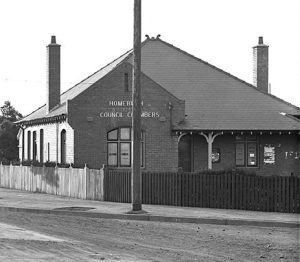
Homebush Council Chambers, 1921 (cropped). Courtesy NSW State Archives and Records
The building was officially opened on Wednesday evening, 19 February 1913. It was crowded with ratepayers as speeches were made. But after the aldermen withdrew for their usual fortnightly meeting ‘the rowdy element took the upper hand… The uproar continued for some time. Alderman Austin appeared on the scene, and mounting the platform endeavoured to restore order, but without success. With expressions of disgust, Alderman Austin left the hall, and the uproar continued until a late hour.’ [4] The cause of the ruckus remains unclear.
Just a few months later Homebush Council hosted a conference in the new chambers, inviting aldermen from surrounding councils to discuss the vexatious issue of Parramatta Road. The Homebush aldermen had long been concerned about the state of the major road on their doorstep. As well as increasing motor traffic, horses and carts etc., was the added nuisance of cattle and sheep from the Homebush Saleyards being herded to the State Abattoir at Glebe Island on Monday and Thursday nights. The deplorable condition of Parramatta Road remained a contentious issue for many years.
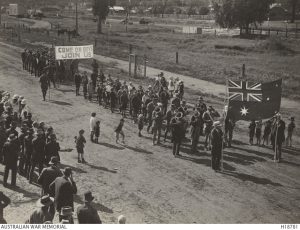
‘Coo-ee’ March in Geurie, NSW near the beginning of their trek to Sydney, October 1915. Courtesy Australian War Memorial.
During November 1915 this stretch of Parramatta Road welcomed the ‘Coo-ee’ march to Homebush. After the carnage at Gallipoli, new recruits were desperately needed for the war effort. When 25 men from Gilgandra decided to enlist they spent five weeks marching the 515 km to Sydney, recruiting along the way. As news of the march spread, they were welcomed in every town. On 11 November they arrived in Homebush. Picture the scene if you can.
‘The Coo-ees struck the fringe of the metropolitan area this afternoon, when they crossed the boundary of the Homebush municipality. From an early hour, there were signs of unusual excitement about this quiet suburb. A string of flags fluttered across Parramatta Road near the local Council Chambers, where the road was lined with benches for spectators. From 11 o’clock, residents in holiday dress and children of the Homebush School began to assemble, while multitudes of tiny flags and sprigs of foliage were waving in the hands of the excited youngsters and their elders alike. Down the road the kerbing was fringed with people, and at the Horse and Jockey Hotel, a dense crowd gathered, producing with the gay bunting and music of bands, an animated scene.
At a quarter past one, the news was flashed along the road – “They are coming” and five minutes later the watchers on the hill which commands an extensive view towards Lidcombe, caught their first sight of the Gilgandra recruits far down the long, dusty road. As the column drew nearer, the sound of a drum was heard, and soon, amid cheers and shouted greeting, and a chorus of welcoming whistles from the trains, sirens and motor horns, the men halted opposite the Homebush Council Chambers, where the Mayor of Homebush (Alderman Austin) and the Acting Mayor of Strathfield (Alderman Firth) extended a welcome to which the recruits responded with three cheers and vigorous “coo-ees”. The Mayoress of Homebush presented Captain Hitchens and other officers with khaki handkerchiefs.’[5]
By the time the ‘Coo-ee’ March reached the city the following day there were 263 recruits for the AIF.
No doubt the Council Chambers were in constant use during the war. The following year, during September 1916, Sergeant Fred King of Burwood was given a farewell there as he headed off to the front.[6] But there were security issues too. During 1917 a typewriter worth £9 was stolen from the Council Chambers[7] and in 1922 thieves gained entry through a fanlight before attempting to blow up the safe with gelignite. They were disturbed and nothing was stolen.[8] Three youths were convicted in Burwood Court for breaking into the Council Chambers just before Christmas 1931 with the intention to steal.[9]
Over the years, Homebush Council Chambers would provide a place for local residents to meet and celebrate. From political speeches to wedding receptions, kitchen teas, card parties, dances, 21st birthdays[10] and bar mitzvahs[11], it provided a communal space for the people of Homebush. A wedding reception for the daughter of Alderman Pilgrim of Strathfield was held there in May 1915[12] while Nata Cooper and Jack MacPherson hosted their wedding guests there in 1928 after the ceremony at St. Anne’s Church of England. The mother of the bride received the guests ‘gowned in navy blue crepe de Chine heavily embroidered with gold and cerise, with hat to tone, and carrying a posy of scarlet petunias.’[13]
Not all occasions were quite as enjoyable. Shockingly, in November 1937, a home-made bomb exploded next to the Town Clerk’s car while the Council meeting was in progress. The bomb had been deliberately placed next to the car belonging to Hesketh Kerruish, the Town Clerk. The mayor and aldermen rushed from their seats.
‘The force of the explosion was so great that people ran from the picture-show hundreds of yards away. They were soon joined by residents, who came from all directions.’[14]
The Town Clerk was severely shaken and his car was badly damaged. Newspapers thoughout Australia reported on the incident.
‘It seems clear that I have been singled out, for the cars of several aldermen were in the street within easy reach, while a fence had to be climbed to get at mine.’
The police were called but it seems that the culprits were never brought to justice. Kerruish served as Town Clerk of Homebush Council for 34 years until 1947.
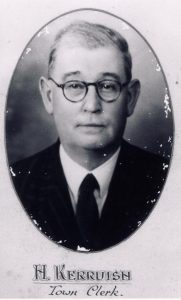
With the advent of WWII the council chambers were again required for wartime activities. In June 1940 the Homebush branch of the Red Cross appealed for donations of flannelette and wool. Members met fortnightly at the council chambers and held a dance there on 29 June 1940.[15] During November 1944 surplus Civilian Aid Stores were sold from the building. With wartime rationing, mattresses, army blankets, tinned food, cutlery and enamelware were eagerly acquired by the ladies of Homebush.[16]
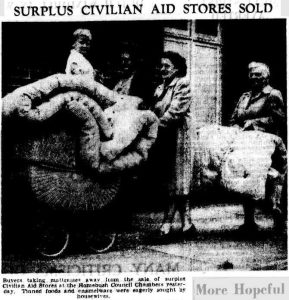
Sydney Morning Herald 3 November 1944 p.3
https://trove.nla.gov.au/newspaper/article/17926391
After the war Homebush and Strathfield Councils were amalgamated and the Homebush Council Chambers resumed use as a social venue rather than a seat of local government. A reception for 130 guests was held there after the wedding of Kathleen Freebody and Denis Fitzgerald in November 1954. Their wedding photo appeared in the Catholic Weekly.[17]
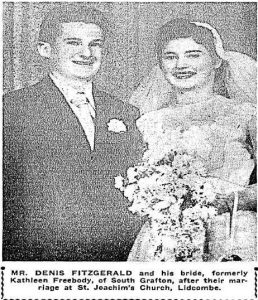
Catholic Weekly 18 November 1954 p.11
https://trove.nla.gov.au/newspaper/article/146800833
By the late 1960s the distinctive triangular site had been sold as Homebush’s population and local industry increased. The site later operated as a car yard for some years. Wagyu Cart now stands where Homebush Council Chambers once hosted the meetings and activities of former residents.
By J.J. MacRitchie
Local Studies Advisor
References
[1] Sydney Morning Herald 5 September 1921 p.10 https://trove.nla.gov.au/newspaper/article/15961640[2] The Daily Telegraph 11 November 1912 p.3 https://trove.nla.gov.au/newspaper/article/238730385
[3] Homebush Council minutes of special meeting, 17 December 1912.
[4] Evening News 20 February 1913 p.14 https://trove.nla.gov.au/newspaper/article/117929501
[5] Evening News 11 November 1915 p.5 https://trove.nla.gov.au/newspaper/article/115276098
[6] Australian Town and Country Journal 13 September 1916 p.35 https://trove.nla.gov.au/newspaper/article/263609844
[7] The Daily Telegraph 8 February 1917 p.6 https://trove.nla.gov.au/newspaper/article/239230608
[8] The Daily Express (Wagga Wagga) 20 May 1922 p.1 https://trove.nla.gov.au/newspaper/article/249084488
[9] Sydney Morning Herald 29 December 1931 p.5 https://trove.nla.gov.au/newspaper/article/16800016
[10] Goulburn Evening Post 22 August 1941 p.2 https://trove.nla.gov.au/newspaper/article/103621118
[11] The Hebrew Standard of Australasia 29 May 1941 p.7 https://trove.nla.gov.au/newspaper/article/121210278
[12] The Cumberland Argus and Fruitgrowers Advocate 22 May 1915 p.2 https://trove.nla.gov.au/newspaper/article/86106451
[13] The Daily Telegraph 7 April 1928 p.11 https://trove.nla.gov.au/newspaper/article/246794542
[14] The Daily Telegraph 11 November 1937 p.1 https://trove.nla.gov.au/newspaper/article/247335373
[15] The Sun 16 June 1940 p.25 https://trove.nla.gov.au/newspaper/article/231470464
[16] Barrier Miner (Broken Hill) 3 November 1944 p.1 https://trove.nla.gov.au/newspaper/article/49550726
[17] Catholic Weekly 18 November 1954 p.11 https://trove.nla.gov.au/newspaper/article/146800833

2 Comments. Leave new
I never thought I’d see the day!
Bravo! It’s so refreshing to see some focus on local history and identity. Articles such as the above, plus exhibitions in the Library plus the photos on the golf course fence plus historical anecdotes popped into the Mayor’s newsletters are most welcome.
Thank you, Elizabeth.